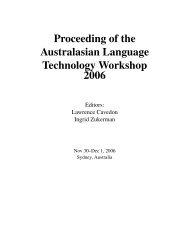The MBC information booklet - RMIT University
The MBC information booklet - RMIT University
The MBC information booklet - RMIT University
You also want an ePaper? Increase the reach of your titles
YUMPU automatically turns print PDFs into web optimized ePapers that Google loves.
CHAPTER 4 Bioinformatics<br />
4.1 Introduction<br />
4.2 Courses<br />
4.2.1 COSC2308—<br />
Advanced<br />
Topics in<br />
Bioinformatics<br />
Chapter 4: Bioinformatics<br />
As the rate of accumulation of biological data increases exponentially, computational tools<br />
for the storage, annotation, querying and modelling of this data become paramount, and<br />
can impose a limitation on data analysis. <strong>The</strong> courses in the Bioinformatics cluster cover<br />
both the creation of algorithms for the analysis of biological data and the use of these to<br />
derive useful and novel <strong>information</strong>. Computational Biology describes the limitations of<br />
current algorithms, and how we can develop superior data analysis and querying tools.<br />
Bioinformatics 1 and 2 describe the use of these tools in the analysis and querying of data,<br />
from a biologist's perspective. Bioinformatics 2 in particular deals with the statistical basis<br />
underlying the tools. Advanced Topics is a course designed to introduce selected current<br />
problems in biological data analysis, and how these may be solved by computational<br />
techniques.<br />
Pursuant to demand, the following courses are available for students who wish to choose<br />
this cluster. <strong>The</strong> courses are:<br />
• COSC2308—Advanced Topics in Bioinformatics (see page 21)<br />
• MATH1300—Analysis of Medical Data (see page 22)<br />
• BIOL2034— Bioinformatics (see page 22)<br />
• COSC2151—Introduction to Computational Biology (see page 22)<br />
Aim<br />
This course presents state-of-the-art algorithms for efficient data analysis and advanced<br />
applications. Students will acquire knowledge about advanced algorithms, architectures<br />
and data structures, learn how to choose appropriate ones to solve complex problems,<br />
and be able to explain their decisions. This course builds on the capabilities acquired in<br />
Computing Fundamentals, and complements the material of the course BIOL2034<br />
Bioinformatics [1].<br />
Objectives<br />
Upon successful completion of this course students should be able to:<br />
• Select appropriate heuristics to address NP-hard problems<br />
• Choose appropriate algorithms and data structures to solve a complex problem<br />
• Compare and evaluate strengths and weaknesses of data structures and algorithms,<br />
and communicate this understanding<br />
Prerequisites<br />
• BIOL2034 Bioinformatics 1<br />
Syllabus<br />
• Methods related to intelligent systems such as simulated annealing, neural networks<br />
and genetic algorithms<br />
• Heuristics for sequence analysis, such as Hidden Markov Models and dynamic<br />
programming<br />
• <strong>The</strong> principles underlying a range of advanced algorithms and data structures,<br />
including most of the following: suffix ties, suffix trees, depth first search, breadth first,<br />
density computation.<br />
• How to compare and evaluate strengths and weaknesses of data structures and<br />
algorithms<br />
21
















